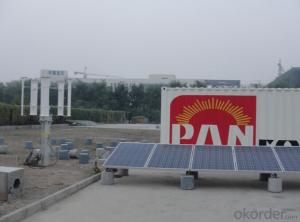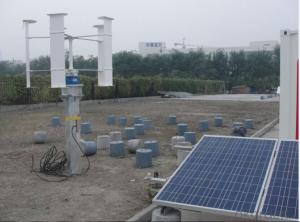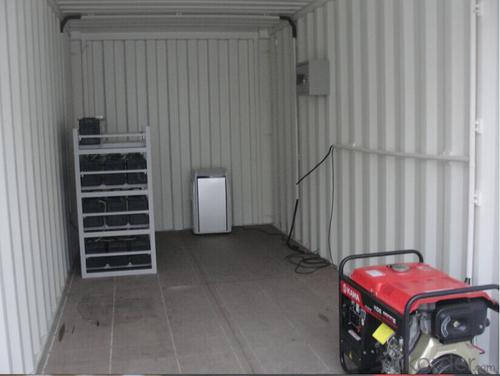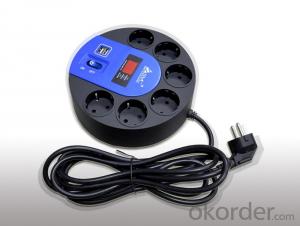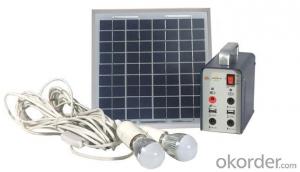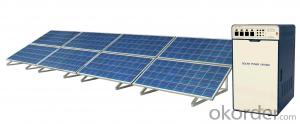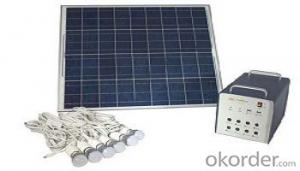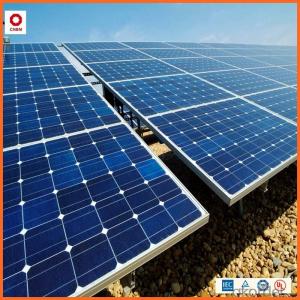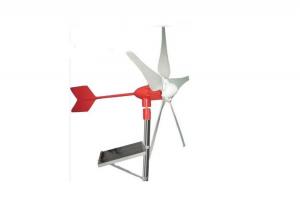Buy Solar Energy Systems - Wind-PV(Diesel) Hybrid Power System
- Loading Port:
- Tianjin
- Payment Terms:
- TT OR LC
- Min Order Qty:
- 2 set
- Supply Capability:
- 30 set/month
OKorder Service Pledge
OKorder Financial Service
You Might Also Like
Specification List
Name | Specification | Quantity | |
1 | Containter | 20*8*8.6ft | 1 |
2 | Solar Module | 240W | 30 |
3 | Wind Generator | 500W | 2 |
4 | Battery | 12V120Ah | 20 |
5 | Controller | 120V/40A | 1 |
6 | Inverter | 6000W/AC230V | 1 |
7 | Diesel | 5000W/AC230V | 1 |
8 | Air Conditioner | 1000W | 1 |
9 | Cables | — | — |
10 | Others | — | — |
2.System Principle
3.System Advantage
Extend battery life |
Reduce the dependence of climate system |
24 hour uninterrupted power supply |
Low maintenance cost |
4.Product Specification
(A) Solar Module
Rated Power | 240W |
Vmppt | 29.4V |
Imppt | 8.17A |
Voc | 37.4V |
Isc | 8.55A |
Power Temp.Coeff(/℃) | -0.47% |
Ambient Temp | -40-85℃ |
Power Tolerance | ±3% |
NOCT | 46℃±2 |
(B) Battery
Rated Voltage | 240V | |
Rated Capacity (C10) | 120Ah | |
Weight | 35kg | |
Dimension | Lenth | 406mm |
Width | 174mm | |
Height | 209mm | |
Capacity | C120 | 150Ah |
C30 | 138Ah | |
C10 | 120Ah | |
C1 | 78Ah | |
Overcharging Protect Voltage | 14.4V/12V | |
Cut off Voltage | 10.8V/12V | |
(C) Wind Generator
Rated Power | 500W |
Rated Wind Speed | 13m/s |
Cut-in Speed | 4m/s |
Cut-out Speed | 25m/s |
Survival Wind Speed | 45m/s |
Mill Diameter | 1.36m |
Mill Height | 1.05m |
Mill Weight | 90kg |
Rated Voltage | AC 42V |
Rated Current | AC 6.9A |
Protection Level | IP54 |
(D) Controller
Solar Controller
Rated Power | 7.2KW |
MPPT | DC120V-350V |
Rated Voltage | DC 120V |
Rated Current | 60A |
Conversion Efficiency | ≥93% |
Overload Capacity | 120% output, 30mins |
Wind Generator Controller
Rated Power | 500W |
Maximum Power | 750W |
Rated Voltage | AC 42V |
E) Inverter
Rated Power | 6000W |
Rated Input Voltage | DC 120V |
Rated Input Current | DC 50A |
Rated Output Voltage | AC 230V |
Rated Frequency | 50Hz |
Rated Current | AC 26.1A |
Output Voltage Precision(V) | 230±5% |
Output Frequency Precision(Hz) | 50±0.05 |
Overload Capacity | 120%, 60S; 150%, 10S |
Inverter Efficiency | 80% |
- Q: How do solar energy systems contribute to reducing carbon emissions?
- Solar energy systems play a crucial role in the reduction of carbon emissions through various means. Firstly, solar energy, being a renewable and eco-friendly power source, helps tackle this issue. By utilizing solar panels that convert sunlight into electricity without emitting any greenhouse gases, solar energy eliminates the release of carbon dioxide and other harmful pollutants into the atmosphere, a stark contrast to traditional fossil fuel power plants. Secondly, solar energy has the potential to replace the usage of fossil fuels in multiple sectors. For instance, residential rooftops can be fitted with solar panels to generate electricity for homes, reducing the dependence on coal or natural gas for power generation. Similarly, solar farms can be established to produce large-scale solar power for commercial and industrial purposes. By substituting fossil fuels, solar energy systems contribute to the reduction of carbon emissions associated with electricity generation. Furthermore, solar energy can also be utilized for heating purposes. Solar thermal systems can capture the sun's heat and provide hot water for residential and commercial buildings. By incorporating solar thermal systems, the demand for gas or electricity to heat water diminishes, resulting in a decrease in carbon emissions during the water heating process. Moreover, the widespread adoption of solar energy systems can lead to an overall decrease in the demand for fossil fuels. As more households, businesses, and industries transition to solar power, the need for coal, oil, and natural gas diminishes. Consequently, this reduced demand for fossil fuels can drive down their production and consumption, resulting in a significant reduction in carbon emissions associated with their extraction, refining, and combustion. In conclusion, solar energy systems contribute to the reduction of carbon emissions by producing clean and renewable electricity, replacing fossil fuels, reducing the demand for traditional energy sources, and providing an alternative for heating purposes. By embracing solar power, we can make substantial progress in combating climate change and strive towards a sustainable future.
- Q: Can solar energy systems be used in powering religious institutions like churches or temples?
- Yes, solar energy systems can definitely be used to power religious institutions like churches or temples. Solar panels can be installed on the rooftops or surrounding areas of these buildings to harness sunlight and convert it into electricity. This renewable energy source can help reduce the carbon footprint of these institutions, lower their energy costs, and serve as a sustainable and environmentally-friendly solution for their power needs.
- Q: Can solar energy systems be used for powering military bases?
- Yes, solar energy systems can be used to power military bases. In fact, many military bases around the world are increasingly adopting solar energy as a reliable and sustainable source of power. Solar panels can be installed on rooftops, open spaces, or even integrated into buildings' facades, providing clean electricity to support the energy needs of military facilities. This not only helps reduce reliance on fossil fuels but also enhances energy security and resilience for military operations.
- Q: Are there any financing options available for purchasing solar energy systems?
- Yes, there are several financing options available for purchasing solar energy systems. These include solar loans, leases, power purchase agreements (PPAs), and government incentives such as tax credits and grants. These options aim to make solar energy more affordable and accessible for individuals and businesses.
- Q: Can solar energy systems be used in powering restaurants or food chains?
- Yes, solar energy systems can definitely be used to power restaurants or food chains. Solar energy is a renewable and sustainable source of power that can help reduce operating costs and minimize the environmental impact of these establishments. Solar panels can be installed on rooftops or in open areas to capture sunlight and convert it into electricity. This electricity can then be used to power various operations in restaurants, such as lighting, refrigeration, cooking equipment, and air conditioning. By utilizing solar power, restaurants and food chains can not only save on their energy bills but also demonstrate their commitment to sustainability and green practices. Additionally, some governments offer incentives and tax benefits for businesses that choose to install solar energy systems, making it an even more attractive option. Overall, solar energy systems are a practical and environmentally-friendly solution for powering restaurants and food chains.
- Q: Can solar energy systems be used for powering factories?
- Yes, solar energy systems can certainly be used for powering factories. Solar panels can be installed on the rooftops or open spaces around factories to capture sunlight and convert it into electricity. This renewable energy source can provide a significant portion or even the entire energy needs of a factory, reducing reliance on non-renewable sources and lowering carbon emissions.
- Q: What is the role of trackers in solar energy systems?
- Trackers in solar energy systems are responsible for increasing the efficiency and performance of solar panels by aligning them with the sun's position throughout the day. These devices track the sun's movement and adjust the angle and position of the panels to maximize the amount of sunlight they receive, ultimately generating more electricity and increasing the overall energy output of the system.
- Q: How does net metering work with solar energy systems?
- Net metering is a billing system that allows solar energy system owners to receive credit for the excess electricity they generate and send back to the grid. When a solar system produces more electricity than is needed, the excess is fed into the utility grid, and the meter records this as a credit. During times when the solar system does not produce enough electricity, such as at night, the owner can use the credits to offset their electricity consumption from the grid. This way, net metering allows solar energy system owners to save money by effectively spinning their meter backward and only paying for the net amount of electricity they use.
- Q: How does the quality of solar panels impact energy production?
- The quality of solar panels has a direct impact on energy production. High-quality solar panels are designed to efficiently convert sunlight into electricity, resulting in higher energy production. These panels are made with advanced technology and high-grade materials that maximize the absorption and conversion of solar energy. On the other hand, low-quality solar panels may have lower efficiency and durability. They may be made with cheaper materials and less advanced technology, leading to a lower energy production capacity. These panels may not be able to capture and convert as much sunlight into usable electricity, resulting in lower energy output. The quality of solar panels also affects their lifespan and reliability. High-quality panels are often built to withstand harsh weather conditions and have longer warranties, ensuring consistent energy production over many years. Low-quality panels may degrade faster and have shorter lifespans, leading to a decline in energy production over time. Therefore, investing in high-quality solar panels is crucial for maximizing energy production and ensuring long-term performance. Although they may be initially more expensive, the increased efficiency and durability of high-quality panels often result in higher energy savings and a faster return on investment.
- Q: Can solar energy systems be used to power vehicles?
- Yes, solar energy systems can be used to power vehicles. Solar panels can be installed on vehicles to convert sunlight into electricity, which can then be used to charge the vehicle's batteries. This renewable energy source provides an environmentally friendly alternative to traditional fossil fuels, reducing both carbon emissions and reliance on non-renewable resources. However, the efficiency and range of solar-powered vehicles are still being improved, and they are currently more commonly used for short-distance travel or as supplemental power sources.
Send your message to us
Buy Solar Energy Systems - Wind-PV(Diesel) Hybrid Power System
- Loading Port:
- Tianjin
- Payment Terms:
- TT OR LC
- Min Order Qty:
- 2 set
- Supply Capability:
- 30 set/month
OKorder Service Pledge
OKorder Financial Service
Similar products
Hot products
Hot Searches
Related keywords

